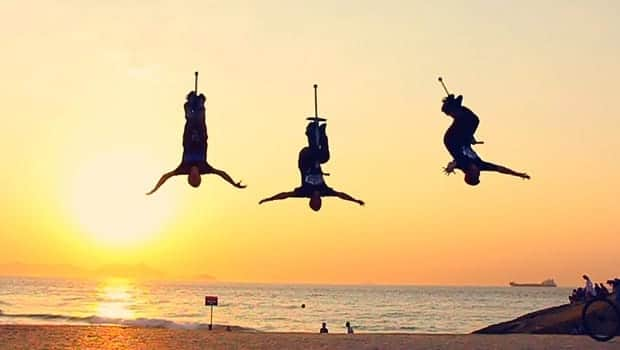Pogo sticks are not just for kids—they have evolved from simple toys into fitness equipment and even an extreme sport. Whether you’re a beginner looking to have fun or an athlete aiming to perform incredible tricks, the pogo stick offers a unique, gravity-defying experience. In this article, we’ll explore everything you need to know about pogo sticks, from their history and invention to modern uses and the emerging culture of extreme pogo (Xpogo).
What is a Pogo Stick? Understanding the Basics

A pogo stick is a jumping device that allows users to launch themselves off the ground by using the power of a spring or other high-performance technologies. It’s essentially a vertical pole with footrests near the bottom, a handle at the top, and a powerful spring somewhere along the middle. By bending their knees and pressing down, users compress the spring, which then recoils, propelling them into the air.
- How It Works: The user stands on the footrests and holds onto the handle while bending and extending their knees to compress the spring. When released, the spring’s energy pushes the user upward, allowing them to bounce repeatedly. Steering is achieved by shifting weight in the desired direction, making horizontal movement possible.
- Types of Pogo Sticks: Today, pogo sticks range from the classic coil-spring designs to advanced models like the Vurtego, Flybar, and BowGo, which enable jumps as high as 10 feet or more.
A Brief History of the Pogo Stick
The concept of a spring-loaded jumping device dates back to the late 19th century, with various inventions laying the groundwork for the modern pogo stick.
Early Origins and First Patents
- George H. Herrington’s Spring Stilts (1881): The earliest predecessor of the pogo stick was invented by George H. Herrington, who patented a “spring stilt” in 1881. This device used compression springs on each foot, designed to help the user leap over large distances.
- Pohlig and Gottschall’s Invention (1920): The modern pogo stick as we know it was created by Max Pohlig and Ernst Gottschall in Germany. In 1920, they patented the “spring end hopping stilt,” which laid the foundation for the classic pogo stick design. It’s believed that the name “pogo” originated from the first two letters of the inventors’ last names.
The Two-Handle Design by George B. Hansburg (1957)
- In 1957, George B. Hansburg patented a new pogo stick design featuring two handles, making it more stable and safer to use. Hansburg’s invention also popularized the name “pogo,” inspired by a story about a young Burmese girl named Pogo who used the device to travel to a local temple.
- Modern Improvements: Over time, new variations and improvements have been made, such as the introduction of air-powered pogo sticks like the Vurtego, which use air pressure to achieve higher jumps and perform complex tricks.
The Rise of Xpogo: Pogo Sticks as an Extreme Sport
While most people think of pogo sticks as simple toys, they’ve become the centerpiece of an emerging extreme sport known as Xpogo (Extreme Pogo).
What is Xpogo?
Xpogo involves performing tricks, stunts, and jumps using extreme pogo sticks that are built for durability and height. These pogo sticks are much more advanced than regular models, capable of reaching over 10 feet in height from the ground to the bottom of the stick.
- Tricks and Stunts: Xpogo athletes perform a wide range of stunts, including flips, spins, and rail slides, making it one of the most visually impressive extreme sports today.
- Competitions and Events: The sport has gained significant traction over the years, with global events like Pogopalooza, the World Championships of Xpogo, attracting participants and spectators from around the world.
Why Xpogo is Growing in Popularity

The sport’s growth can be attributed to several factors, including:
- Increased Durability and Performance: Modern Xpogo sticks are designed to handle rigorous jumps, offering better safety and higher performance, making them appealing to extreme sports enthusiasts.
- Social Media Exposure: Xpogo has benefited from platforms like YouTube, Instagram, and TikTok, where viral videos showcase athletes performing impressive tricks, helping to bring Xpogo into popular culture.
- Exhibition Teams: Xpogo athletes often form exhibition teams that perform at events, increasing awareness and inspiring a new generation of pogo enthusiasts.
Pogo Stick World Records: Impressive Feats and Achievements
Pogo sticks have not only evolved in design but have also been used to set incredible world records. From long-duration bouncing marathons to jaw-dropping jumps, pogo sticks have proven their versatility.
- Longest Continuous Pogoing: The record for the longest continuous bouncing session stands at 20 hours and 13 minutes, with an astonishing 206,864 consecutive bounces, achieved by James Roumeliotis.
- Highest Pogo Stick Jump: The highest jump on a pogo stick recorded so far reached over 11 feet, setting a new benchmark in the world of extreme pogo.
- Unique Pogo Achievements: Pogo sticks have been used in unusual ways, including pogo weddings, themed jumping contests, and even high-altitude stunts performed by daredevils looking to push the boundaries of the sport.
The Health Benefits of Using a Pogo Stick

While pogo sticks are often seen as toys or extreme sports equipment, they can also be used as effective workout tools. Bouncing on a pogo stick offers a full-body workout, improving both strength and cardiovascular health.
- Cardio and Fat Burning: Pogoing raises your heart rate, making it a great cardiovascular exercise. It’s also an effective way to burn calories while having fun.
- Improved Balance and Coordination: Balancing on a pogo stick engages your core muscles, improving coordination and balance over time. This makes it a great tool for athletes looking to enhance their agility.
- Low-Impact Workout: Unlike running, which can be hard on the joints, bouncing on a pogo stick provides a lower-impact exercise, reducing stress on the knees and ankles.
Safety Tips for Using a Pogo Stick
While pogo sticks can be incredibly fun, safety should always come first. Here are some essential safety tips for beginners and extreme athletes alike:
- Wear Protective Gear: Always wear a helmet, knee pads, and elbow pads, especially if you’re attempting high jumps or tricks.
- Start Slowly: If you’re new to pogoing, start with shorter, slower bounces until you get the hang of balancing and controlling the stick.
- Choose the Right Pogo Stick: Make sure to use a pogo stick that matches your skill level. Beginners should start with a basic model, while experienced jumpers can use advanced sticks designed for tricks and higher jumps.
- Pogo in a Safe Area: Use your pogo stick in a wide-open space, free from obstacles and hard surfaces, to minimize the risk of injury.
Conclusion: The Pogo Stick’s Timeless Appeal
From its invention as a simple hopping stilt to its transformation into a cutting-edge extreme sport, the pogo stick has come a long way. Whether you’re using it for exercise, fun, or performing breathtaking tricks, the pogo stick remains a symbol of playful innovation and daring adventure. With its health benefits, versatility, and potential for excitement, the pogo stick is more than just a childhood toy—it’s a gateway to a world of bouncing possibilities. So, are you ready to jump in?


